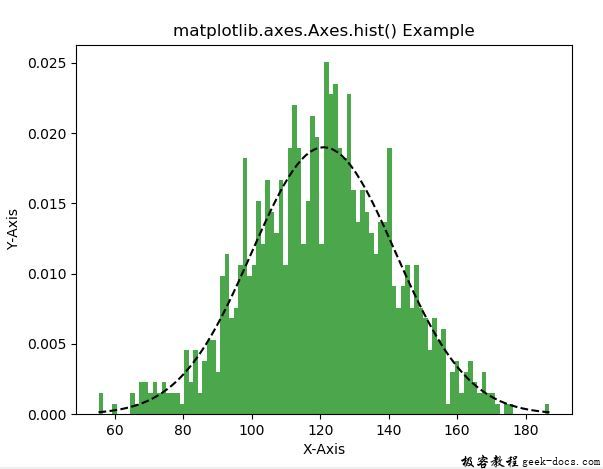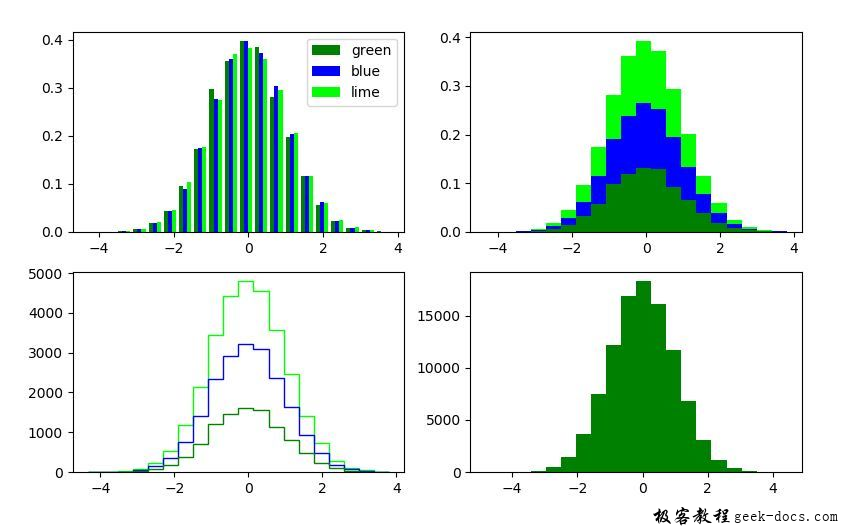matplotlib.axes.axes.hist()
matplotlib.axes.axes.hist()函数,matplotlib库的Axes模块中的Axes.hist()函数用于绘制直方图。
语法:
Axes.hist(self, x, bins=None, range=None, density=None, weights=None, cumulative=False, bottom=None, histtype=’bar’, align=’mid’, orientation=’vertical’, rwidth=None, log=False, color=None, label=None, stacked=False, normed=None, *, data=None, **kwargs)
参数:该方法接受如下参数说明:
- x:表示数据顺序。
- bins:可选参数,包含整数、序列或字符串。
- range:可选参数,表示容器的上下范围。
- density :可选参数,包含布尔值。
- weights:该参数是一个可选参数,它是一个权重数组,形状与x相同。
- bottom:每个容器的底部基线位置。
- histtype:可选参数,用于绘制直方图的类型。{‘ bar ‘, ‘ barstacked ‘, ‘ step ‘, ‘ stepfill ‘}
- align:该参数是一个可选参数,它控制如何绘制直方图。{“左”、“中”、“右”}
- rwidth:该参数是一个可选参数,它是条的相对宽度,作为bin宽度的一部分
- log:可选参数,用于将直方图轴设置为日志级别
- color:该参数是一个可选参数,它是一个颜色规格或颜色规格序列,每个数据集一个。
- label:该参数是一个可选参数,它是一个字符串,或匹配多个数据集的字符串序列。
- normed:该参数是一个可选参数,它包含布尔值.它使用密度关键字参数代替。
返回如下内容:
- n:这将返回直方图容器的值。
- bins:返回回收箱的边缘。
- patch:返回用于创建直方图的单个补丁的列表。
下面的例子演示了matplotlib.axes中的matplotlib.axes.axes.hexbin()函数:
示例1
# Implementation of matplotlib function
import matplotlib
import numpy as np
import matplotlib.pyplot as plt
np.random.seed(10**7)
mu = 121
sigma = 21
x = mu + sigma * np.random.randn(1000)
num_bins = 100
fig, ax = plt.subplots()
n, bins, patches = ax.hist(x, num_bins,
density = 1,
color ='green',
alpha = 0.7)
y = ((1 / (np.sqrt(2 * np.pi) * sigma)) *
np.exp(-0.5 * (1 / sigma * (bins - mu))**2))
ax.plot(bins, y, '--', color ='black')
ax.set_xlabel('X-Axis')
ax.set_ylabel('Y-Axis')
ax.set_title('matplotlib.axes.Axes.hist() Example')
plt.show()
输出:

示例2
# Implementation of matplotlib function
import matplotlib
import numpy as np
import matplotlib.pyplot as plt
np.random.seed(10**7)
n_bins = 20
x = np.random.randn(10000, 3)
fig, [(ax0, ax1), (ax2, ax3)] = plt.subplots(nrows = 2,
ncols = 2)
colors = ['green', 'blue', 'lime']
ax0.hist(x, n_bins, density = True,
histtype ='bar',
color = colors,
label = colors)
ax0.legend(prop ={'size': 10})
ax1.hist(x, n_bins, density = True,
histtype ='barstacked',
stacked = True,
color = colors)
ax2.hist(x, n_bins, histtype ='step',
stacked = True,
fill = False,
color = colors)
x_multi = [np.random.randn(n) for n in [100000,
80000,
1000]]
ax3.hist(x_multi, n_bins,
histtype ='stepfilled',
color = colors)
plt.show()
输出:

 极客教程
极客教程